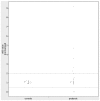Integrative analysis of hereditary nonpolyposis colorectal cancer: the contribution of allele-specific expression and other assays to diagnostic algorithms
- PMID: 24278394
- PMCID: PMC3835792
- DOI: 10.1371/journal.pone.0081194
Integrative analysis of hereditary nonpolyposis colorectal cancer: the contribution of allele-specific expression and other assays to diagnostic algorithms
Abstract
The identification of germline variants predisposing to hereditary nonpolyposis colorectal cancer (HNPCC) is crucial for clinical management of carriers, but several probands remain negative for such variants or bear variants of uncertain significance (VUS). Here we describe the results of integrative molecular analyses in 132 HNPCC patients providing evidences for improved genetic testing of HNPCC with traditional or next generation methods. Patients were screened for: germline allele-specific expression (ASE), nucleotide variants, rearrangements and promoter methylation of mismatch repair (MMR) genes; germline EPCAM rearrangements; tumor microsatellite instability (MSI) and immunohistochemical (IHC) MMR protein expression. Probands negative for pathogenic variants of MMR genes were screened for germline APC and MUTYH sequence variants. Most germline defects identified were sequence variants and rearrangements of MMR genes. Remarkably, altered germline ASE of MMR genes was detected in 8/22 (36.5%) probands analyzed, including 3 cases negative at other screenings. Moreover, ASE provided evidence for the pathogenic role and guided the characterization of a VUS shared by 2 additional probands. No germline MMR gene promoter methylation was observed and only one EPCAM rearrangement was detected. In several cases, tumor IHC and MSI diverged from germline screening results. Notably, APC or biallelic MUTYH germline defects were identified in 2/19 probands negative for pathogenic variants of MMR genes. Our results show that ASE complements gDNA-based analyses in the identification of MMR defects and in the characterization of VUS affecting gene expression, increasing the number of germline alterations detected. An appreciable fraction of probands negative for MMR gene variants harbors APC or MUTYH variants. These results indicate that germline ASE analysis and screening for APC and MUTYH defects should be included in HNPCC diagnostic algorithms.
Conflict of interest statement
Figures


Similar articles
-
MLH1 promoter germline-methylation in selected probands of Chinese hereditary non-polyposis colorectal cancer families.World J Gastroenterol. 2008 Dec 28;14(48):7329-34. doi: 10.3748/wjg.14.7329. World J Gastroenterol. 2008. PMID: 19109866 Free PMC article.
-
Colon and endometrial cancers with mismatch repair deficiency can arise from somatic, rather than germline, mutations.Gastroenterology. 2014 Dec;147(6):1308-1316.e1. doi: 10.1053/j.gastro.2014.08.041. Epub 2014 Sep 3. Gastroenterology. 2014. PMID: 25194673 Free PMC article.
-
Lynch syndrome (hereditary nonpolyposis colorectal cancer) diagnostics.J Natl Cancer Inst. 2007 Feb 21;99(4):291-9. doi: 10.1093/jnci/djk051. J Natl Cancer Inst. 2007. PMID: 17312306
-
Mismatch repair genes founder mutations and cancer susceptibility in Lynch syndrome.Clin Genet. 2015 Jun;87(6):507-16. doi: 10.1111/cge.12529. Epub 2014 Dec 9. Clin Genet. 2015. PMID: 25345868 Review.
-
Correlation of tumour BRAF mutations and MLH1 methylation with germline mismatch repair (MMR) gene mutation status: a literature review assessing utility of tumour features for MMR variant classification.J Med Genet. 2012 Mar;49(3):151-7. doi: 10.1136/jmedgenet-2011-100714. J Med Genet. 2012. PMID: 22368298 Review.
Cited by
-
Genetic landscape of pancreatic adenocarcinoma patients: a pilot study from Pakistan.Mol Biol Rep. 2022 Feb;49(2):1341-1350. doi: 10.1007/s11033-021-06964-z. Epub 2021 Nov 23. Mol Biol Rep. 2022. PMID: 34812998
-
Sporadic and Lynch syndrome-associated mismatch repair-deficient brain tumors.Lab Invest. 2022 Feb;102(2):160-171. doi: 10.1038/s41374-021-00694-3. Epub 2021 Nov 30. Lab Invest. 2022. PMID: 34848827 Free PMC article.
-
Functional interrogation of Lynch syndrome-associated MSH2 missense variants via CRISPR-Cas9 gene editing in human embryonic stem cells.Hum Mutat. 2019 Nov;40(11):2044-2056. doi: 10.1002/humu.23848. Epub 2019 Aug 17. Hum Mutat. 2019. PMID: 31237724 Free PMC article.
-
Involvement of MBD4 inactivation in mismatch repair-deficient tumorigenesis.Oncotarget. 2015 Dec 15;6(40):42892-904. doi: 10.18632/oncotarget.5740. Oncotarget. 2015. PMID: 26503472 Free PMC article.
-
Evolving approach and clinical significance of detecting DNA mismatch repair deficiency in colorectal carcinoma.Semin Diagn Pathol. 2015 Sep;32(5):352-61. doi: 10.1053/j.semdp.2015.02.018. Epub 2015 Feb 4. Semin Diagn Pathol. 2015. PMID: 25716099 Free PMC article. Review.
References
-
- Burn J, Gerdes AM, Macrae F, Mecklin JP, Moeslein G et al. (2011) Long-term effect of aspirin on cancer risk in carriers of hereditary colorectal cancer: an analysis from the CAPP2 randomised controlled trial. Lancet 378: 2081-2087. doi:10.1016/S0140-6736(11)61049-0. PubMed: 22036019. - DOI - PMC - PubMed
-
- Wagner A, Barrows A, Wijnen JT, van der Klift H, Franken PF et al. (2003) Molecular analysis of hereditary nonpolyposis colorectal cancer in the United States: high mutation detection rate among clinically selected families and characterization of an American founder genomic deletion of the MSH2 gene. Am J Hum Genet 72: 1088-1100. doi:10.1086/373963. PubMed: 12658575. - DOI - PMC - PubMed
-
- Mueller J, Gazzoli I, Bandipalliam P, Garber JE, Syngal S et al. (2009) Comprehensive molecular analysis of mismatch repair gene defects in suspected Lynch syndrome (hereditary nonpolyposis colorectal cancer) cases. Cancer Res 69: 7053-7061. doi:10.1158/0008-5472.CAN-09-0358. PubMed: 19690142. - DOI - PMC - PubMed
Publication types
MeSH terms
Substances
Grants and funding
LinkOut - more resources
Full Text Sources
Other Literature Sources
Medical
Research Materials
Miscellaneous

